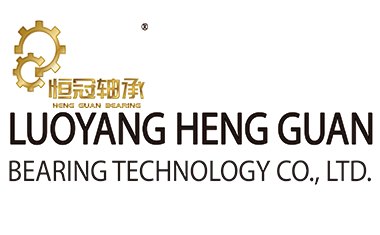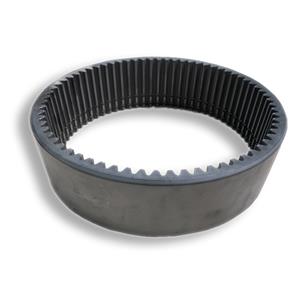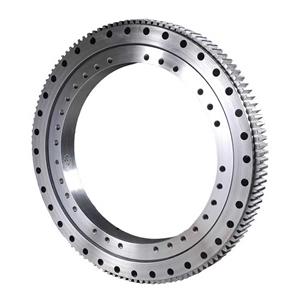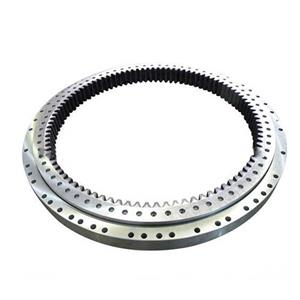Detailed introduction of slewing bearing specifications
1. How to reasonably select slewing bearings
The calculation and selection of the slewing bearing is based on the torque, speed, axial load of the supporting host and the through hole diameter of the supporting host. In addition to providing specifications and parameters of slewing bearings, each manufacturer also provides
Respective static load carrying capacity curves. The selection of slewing bearings is generally carried out according to the following process:
① Determine the maximum static load (axial force, radial force and torque) borne by the slewing bearing, and use this load as the static rated load;
② Determine the static safety factor. The recommended safety factor for the supporting host is 1.45;
③ Calculate the static load axial force and torque according to the calculation formula given by the manufacturer to select the slewing bearing model;
④ Check the bolt bearing capacity.
2. Slewing support structure
The slewing bearing is mainly composed of rolling elements, inner ring and outer ring gear. The inner ring and outer ring gear are fixed with the slewing sleeve and shell respectively by high-strength bolts. The installation bolts must comply with the standards of GB 3098.1 and GB 5782, and shall not be lower than high-strength bolts of grade 8.8. Use flat washers or nuts with double-sided anti-loosening threads and hardened to prevent loosening. A certain pre-tightening force must be ensured when installing bolts, which should be 0.65 to 0.7 times the yield limit of the bolts. Check the bolt pretightening force after the equipment has been running for 100 hours, and every 400 hours thereafter. Add No. 2 extreme pressure lithium grease once every 100 hours of operation.
The slewing bearing is a ball or roller bearing slewing device. It is developed on the basis of ordinary rolling bearings and is structurally equivalent to an enlarged rolling bearing. Therefore, it is also called "large (or extra large) rolling bearing". Since slewing bearings have many outstanding advantages, they have been widely used in excavators, cranes and other engineering machinery in recent years.
Generally, the stiffness of the inner and outer rings of rolling bearings is ensured by the assembly of the shaft and the bearing seat, while the stiffness of the slewing bearing is ensured by the chassis structure that supports it.
The slewing bearing has a low rotation speed and usually bears axial load, radial load and overturning moment. Therefore, the number of load cycles at the contact point on the raceway of the slewing bearing is small. In the design calculation, the load-bearing capacity is mainly calculated to determine the maximum contact stress at the contact point between the rolling element and the raceway.
Commonly used slewing bearing devices can be divided into the following four structures according to the shape and arrangement of rolling elements:
1. Single row 4-point contact ball slewing bearing. It consists of 2 seat rings. The rolling elements are spherical. Each rolling element has 4 points of contact with the raceway and can withstand axial force, radial force and torque at the same time. The slewing ring is also a ring gear, which is suitable for small and medium-sized supporting hosts
2. Single row crossed roller slewing bearing. It consists of 2 races, the rolling elements are cylindrical, the axes of adjacent rolling elements are arranged crosswise, and the contact pressure angle is 45°. Since the rolling elements and raceways are in line contact, the load-bearing capacity is higher than that of the single-row steel ball type. This kind of slewing bearing device has high manufacturing precision, small assembly gap and high installation accuracy requirements. It is suitable for small and medium-sized supporting hosts (see Figure 2-b)
3. Double rows of ball slewing bearings with different diameters. It has 3 seats, which are assembled in an open style, and the upper and lower rows of steel balls use different diameters to adapt to differences in stress states. Due to the large contact pressure angle of the raceway (60° ~ 90°), it can withstand large axial force and torque, and is suitable for medium-sized supporting hosts .
4. Three rows of roller slewing bearings. It has 3 seat rings that separate the upper, lower and radial raceways. The upper and lower rows of rollers are arranged horizontally and parallel to bear axial load and torque. The vertically arranged rollers on the radial raceway bear the radial load. It is the one with the largest load-bearing capacity among the four commonly used shapes of slewing bearings. It is suitable for high-torque main engines with larger through-hole diameters




